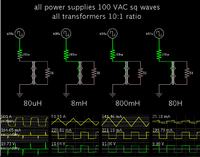peeyushsigma
Member level 4

- Joined
- Apr 15, 2012
- Messages
- 77
- Helped
- 19
- Reputation
- 38
- Reaction score
- 17
- Trophy points
- 1,288
- Location
- Bengaluru, Karnataka, India
- Activity points
- 1,774
hello everyone,
my question is what will be the output at the secondary of the transformer if we apply square wave at the primary side (suppose step down transformer of 10:1) of a transformer used in PSUs.
simulation in "NI-Multisim" shows the exact square wave with reduces amplitude by factor of 10...but i am not satisfied i was expecting impulses at the output.
my question is what will be the output at the secondary of the transformer if we apply square wave at the primary side (suppose step down transformer of 10:1) of a transformer used in PSUs.
simulation in "NI-Multisim" shows the exact square wave with reduces amplitude by factor of 10...but i am not satisfied i was expecting impulses at the output.



